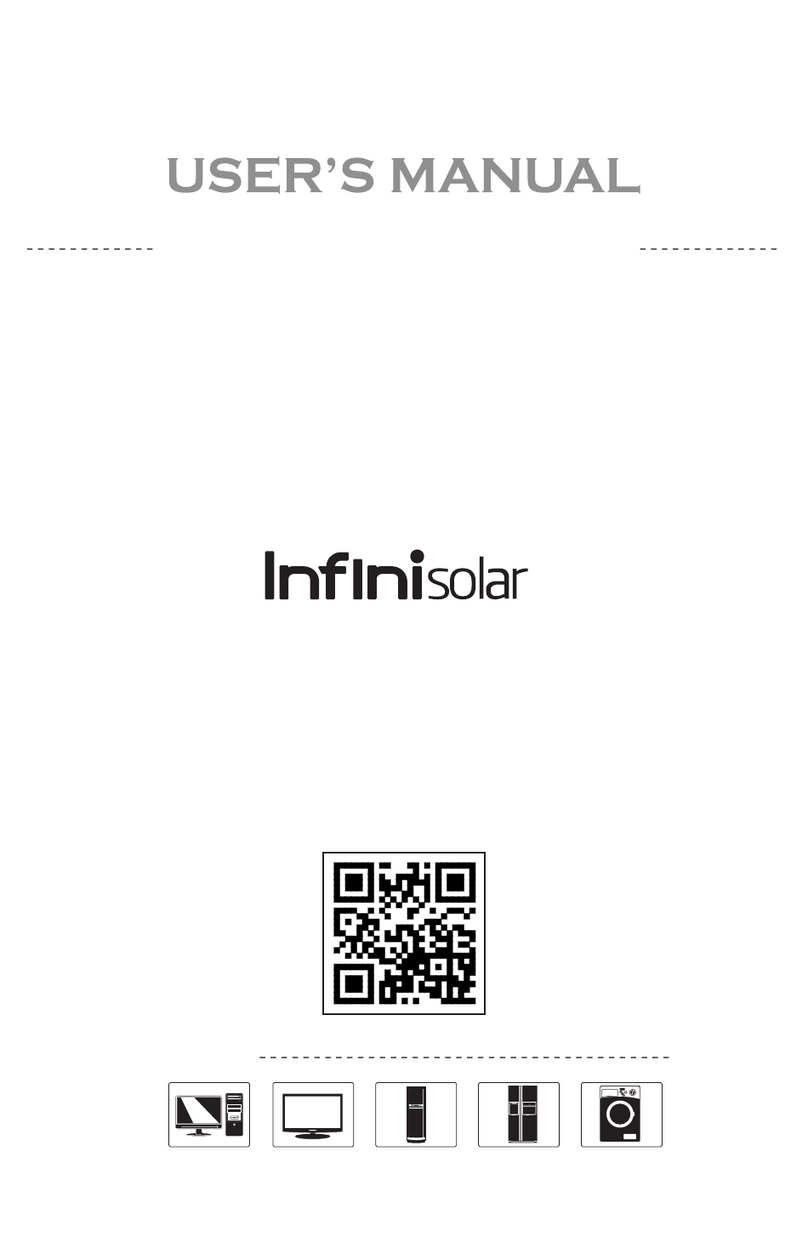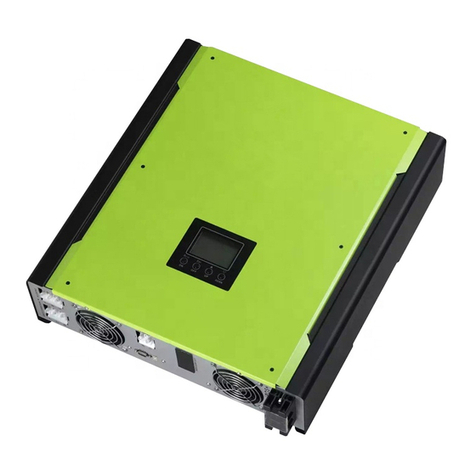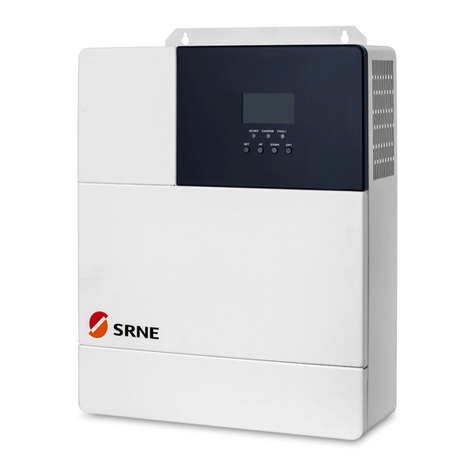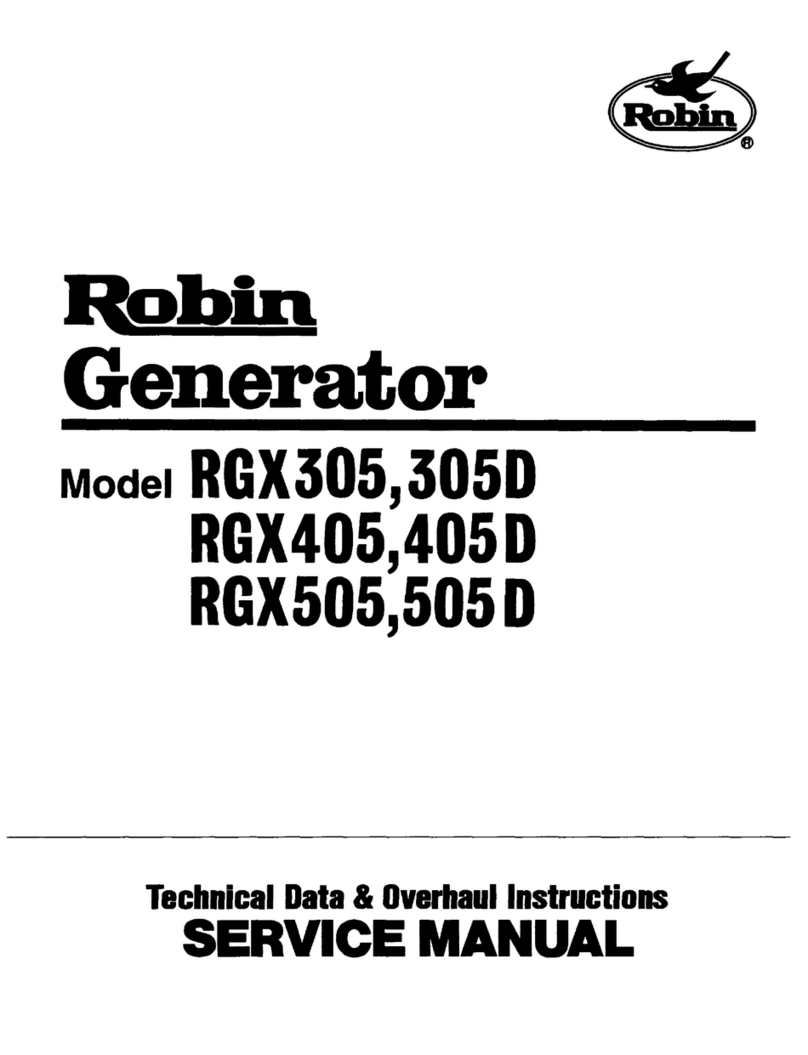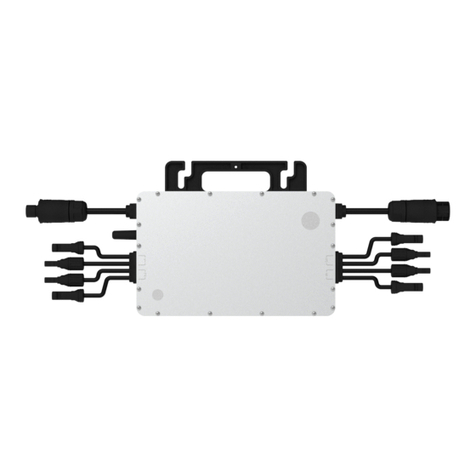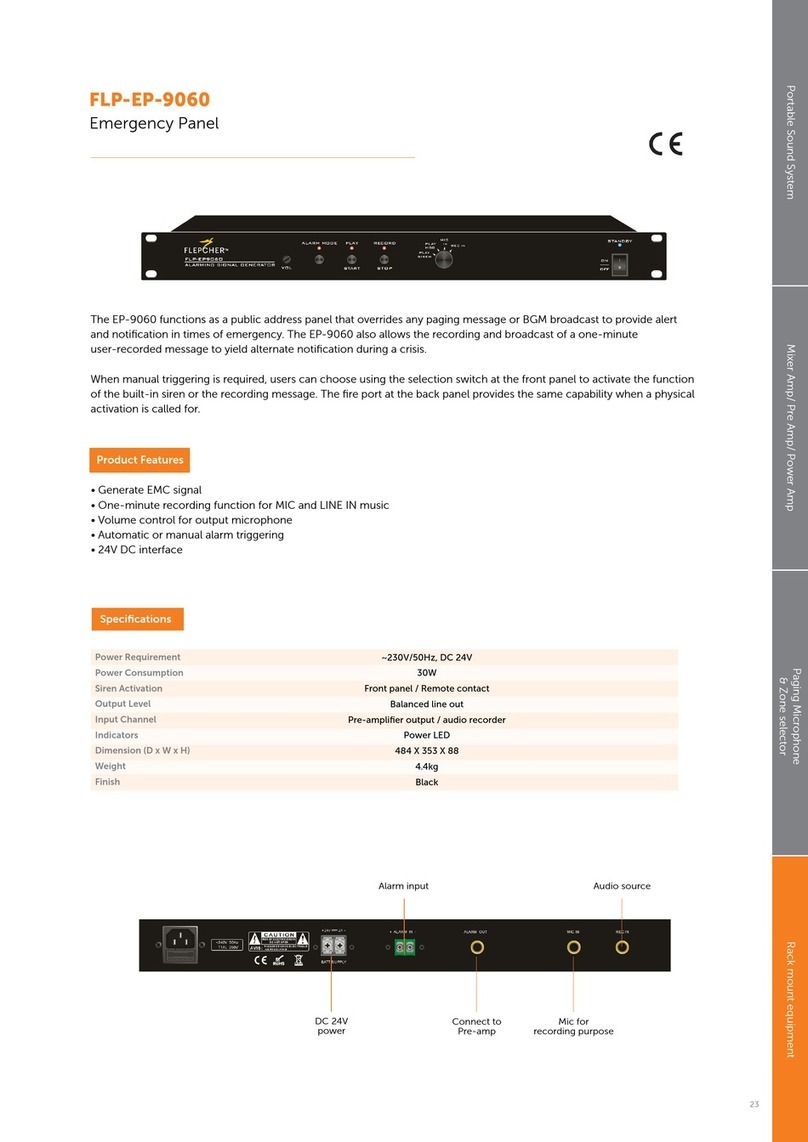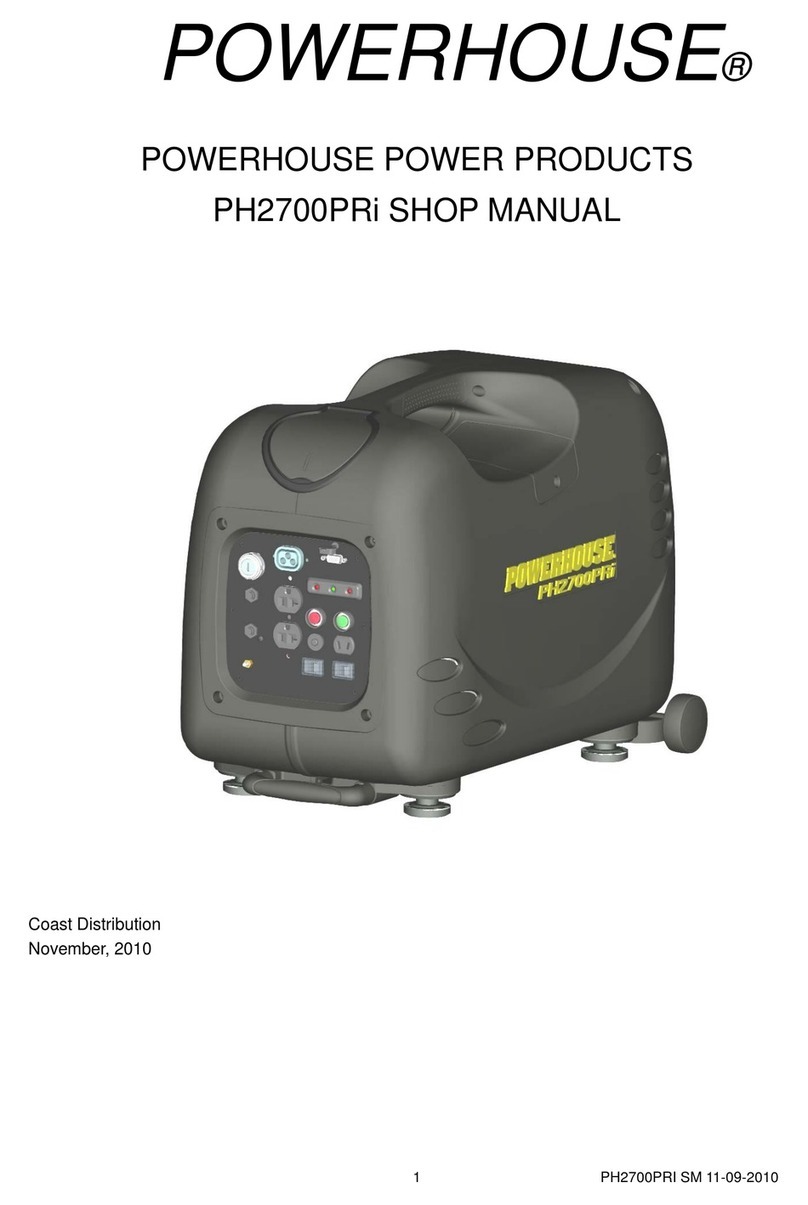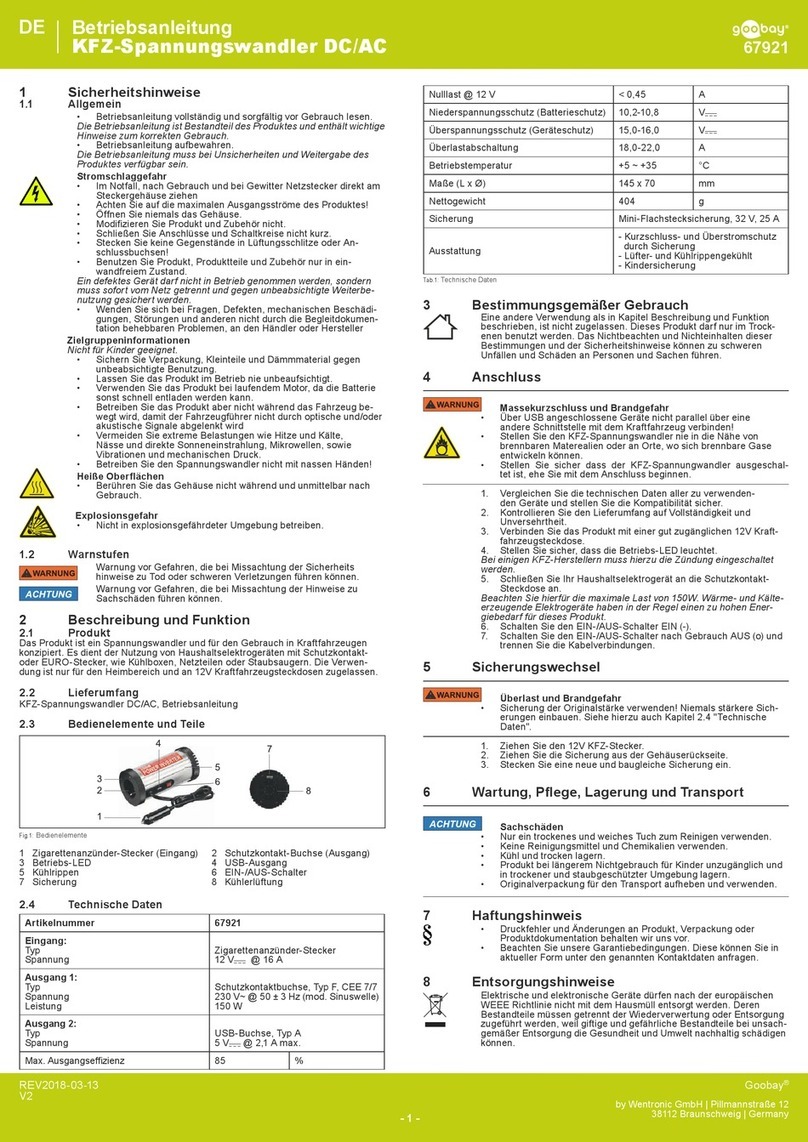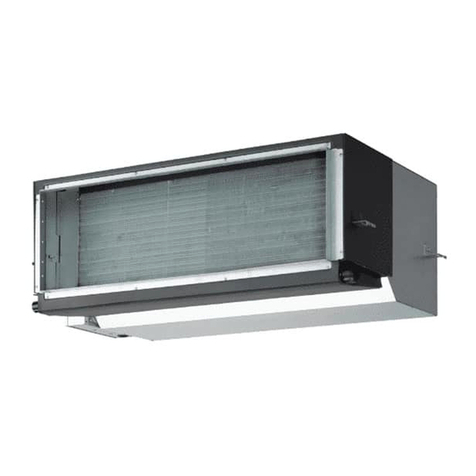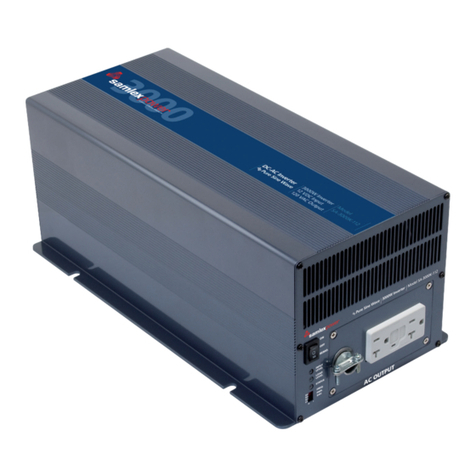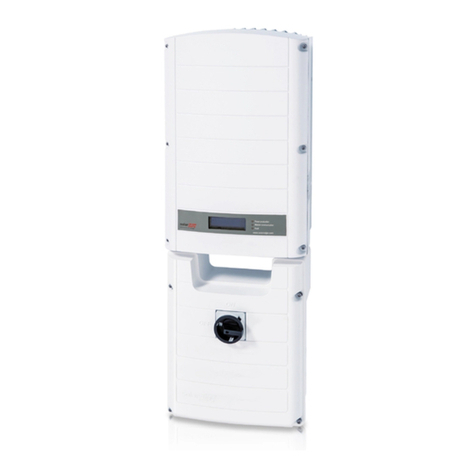InfiniSolar 10KW User manual

Hybrid 10KW PV Inverter
Version: 1.1
User Manual

Table Of Contents
1. Introduction.......................................................................................... 1
2. Important Safety Warning...................................................................... 2
3. Unpacking & Overview .......................................................................... 4
3-1. Packing List................................................................................... 4
3-2. Product Overview .......................................................................... 4
4. Installation ........................................................................................... 5
4-1. Selecting Mounting Location........................................................... 5
4-2. Mounting Unit ............................................................................... 5
5. Grid (Utility) Connection ........................................................................... 7
5-1. Preparation ................................................................................... 7
5-2. Connecting to the AC Utility ........................................................... 7
6. PV Module (DC) Connection ................................................................... 9
7. Battery Connection...............................................................................12
8. Load (AC Output) Connection ...............................................................13
8-1. Preparation ..................................................................................13
8-2. Connecting to the AC output .........................................................13
9. Communication ....................................................................................15
10. Dry Contact Signal ...............................................................................16
10-1. Pin Configuration ........................................................................16
10-2 Cable Preparation ........................................................................17
10-3. Function Description ...................................................................17
11. Relay Control Port ................................................................................19
11.1. Interface Configuration ...............................................................19
11.2. Function Description ...................................................................19
11.3. Application .................................................................................20
12. Application with Energy Meter...............................................................21
13. Commissioning.....................................................................................22
14. Initial Setup .........................................................................................23
15. Operation ............................................................................................35
12-1. Interface....................................................................................35
12-2. LCD Information Define ..............................................................35
12-3. Button Definition ........................................................................36
12-4 Query Menu Operation.................................................................37
12-5. Operation Mode & Display...........................................................40
16. Charging Management .........................................................................44
14. Maintenance & Cleaning.........................................................................46
15. Trouble Shooting ...................................................................................47
15-1. Warning List...............................................................................47
15-2. Fault Reference Codes ................................................................48
16. Specifications ........................................................................................50

1
1. Introduction
This hybrid PV inverter can provide power to connected loads by utilizing PV power,
utility power and battery power.
Figure 1 Basic hybrid PV System Overview
Depending on different power situations, this hybrid inverter is designed to generate
continuous power from PV solar modules (solar panels), battery, and the utility. When
MPP input voltage of PV modules is within acceptable range (see specification for the
details), this inverter is able to generate power to feed the grid (utility) and charge
battery. This inverter is only compatible with PV module types of single crystalline and
poly crystalline. Do not connect any PV array types other than these two types of PV
modules to the inverter. Do not connect the positive or negative terminal of the solar
panel to the ground. See Figure 1 for a simple diagram of a typical solar system with this
hybrid inverter.
Note: By following the EEG standard, every inverter sold to German area is not allowed
to charge battery from Utility. The relevant function is automatically disabled by the
software.
PV module
Battery
Hybrid inverter
Distribution Box
Electric grids
Load

2
2. Important Safety Warning
Before using the inverter, please read all instructions and cautionary
markings on the unit and this manual. Store the manual where it can be
accessed easily.
This manual is for qualified personnel. The tasks described in this manual may be
performed by qualified personnel only.
General Precaution-
WARNING! Before installing and using this inverter, read all instructions and cautionary
markings on the inverter and all appropriate sections of this guide.
WARNING! Normally grounded conductors may be ungrounded and energized when a
ground fault is indicated.
WARNING! This inverter is heavy. It should be lifted by at least two persons.
CAUTION! Authorized service personnel should reduce the risk of electrical shock by
disconnecting AC, DC and battery power from the inverter before attempting any
maintenance or cleaning or working on any circuits connected to the inverter. Turning off
controls will not reduce this risk. Internal capacitors can remain charged for 5 minutes
after disconnecting all sources of power.
CAUTION! Do not disassemble this inverter yourself. It contains no user-serviceable
parts. Attempt to service this inverter yourself may cause a risk of electrical shock or fire
and will void the warranty from the manufacturer.
CAUTION! To avoid a risk of fire and electric shock, make sure that existing wiring is in
good condition and that the wire is not undersized. Do not operate the Inverter with
damaged or substandard wiring.
Conventions used:
WARNING! Warnings identify conditions or practices that could result in personal
injury;
CAUTION! Caution identify conditions or practices that could result in damaged to the
unit or other equipment connected.

3
CAUTION! Under high temperature environment, the cover of this inverter could be hot
enough to cause skin burns if accidentally touched. Ensure that this inverter is away
from normal traffic areas.
CAUTION! Use only recommended accessories from installer. Otherwise, not-qualified
tools may cause a risk of fire, electric shock, or injury to persons.
CAUTION! To reduce risk of fire hazard, do not cover or obstruct the cooling fan.
CAUTION! Do not operate the Inverter if it has received a sharp blow, been dropped, or
otherwise damaged in any way. If the Inverter is damaged, please call for an RMA
(Return Material Authorization).
CAUTION! AC breaker, DC switch and Battery circuit breaker are used as disconnect
devices and these disconnect devices shall be easily accessible.
Symbols used in Equipment Markings
Refer to the operating instructions
Caution! Risk of danger
Caution! Risk of electric shock
Caution! Risk of electric shock. Energy storage timed
discharge for 5 minutes.
Caution! Hot surface
Before working on this circuit
-Isolate inverter/Uninterruptible Power System (UPS)
-Then check for Hazardous Voltage between all
terminals including the protective earth.
Risk of Voltage Backfeed

4
3. Unpacking & Overview
3-1. Packing List
Before installation, please inspect the unit. Be sure that nothing inside the package is
damaged. You should have received the following items inside of package:
Inverter unit PV connectors AC connector Mounting plate Fixing screws
Software CD Manual USB cable RS-232 cable Relay control port
3-2. Product Overview
1) PV connectors
2) AC Grid connectors
3) Battery connectors
4) AC output connectors (Load
connection)
5) RS-232 communication port
6) USB communication port
7) Intelligent slot
8) Grounding
9) LCD display panel (Please check
section 10 for detailed LCD
operation)
10) Operation buttons
11) Dry contact
12) Battery thermal sensor
13) EPO
14) AC circuit breaker
15) DC Switch
16) Relay control port

5
4. Installation
4-1. Selecting Mounting Location
Consider the following points before selecting where to install:
Do not mount the inverter on flammable construction materials.
Mount on a solid surface
This inverter can make noises during operation which may be perceived as a
nuisance in a living area.
Install this inverter at eye level in order to allow the LCD display to be read at all
times.
For proper air circulation to dissipate heat, allow a clearance of approx. 20 cm to
the side and approx. 50 cm above and below the unit.
Dusty conditions on the unit may impair the performance of this inverter.
The ambient temperature should be between 0°C and 40°C and relative humidity
should be between 5% and 85% to ensure optimal operation.
The recommended installation position is to be adhered to (vertical).
For proper operation of this inverter, please use appropriate cables for grid
connection.
The pollution degree of the inverter is PD2. Select an appropriate mounting
location. Install the solar inverter in a protected area that is dry, free of excessive
dust and has adequate air flow. Do NOT operate it where the temperature and
humidity is beyond the specific limits. (Please check the specs for the limitations.)
Installation position shall not prevent access to the disconnection means.
This inverter is designed with IP20 for indoor applications only.
Regularly clean the fan filter.
4-2. Mounting Unit
Installation to the wall should be implemented with the proper screws. After that, the
device should be bolted on securely.
The inverter only can be used in a CLOSED ELECTRICAL OPERATING AREA.
WARNING!! Remember that this inverter is heavy! Please be carefully when lifting out
from the package.
WARNING!! FIRE HAZARD.
SUITABLE FOR MOUNTING ON CONCRETE OR OTHER NON-COMBUSTIBLE SURFACE
ONLY.

6
1. Drill six holes in the marked
locations with supplied six screws.
The reference tightening torque is
35 N.m.
2. Raise the inverter and place it over
the mounting plate.
3. Fix the inverter in position by
screwing the supplied two screws
(M4*12) located on the top two
sides of the inverter.
4. Check if the inverter is firmly secured.

7
5. Grid (Utility) Connection
5-1. Preparation
NOTE: The overvoltage category of the AC input is III. It should be connected to the
power distribution.
NOTE2: The inverter is built in a 25A/400V breaker to protect the inverter from AC
power damage.
WARNING! It's very important for system safety and efficient operation to use
appropriate cable for grid (utility) connection. To reduce risk of injury, please use the
proper recommended cable size as below.
Suggested cable requirement for AC wire
Nominal Grid Voltage
230VAC per phase
Conductor cross-section (mm2)
4
AWG no.
12
5-2. Connecting to the AC Utility
Overview of AC Connection Socket
Component
Description
A
Pressure dome
B
Sealing nut
C
Protective element
D
Socket element
Step 1: Check the grid voltage and frequency with an AC voltmeter. It should be the
same to “VAC” value on the product label.
Step 2: Turn off the circuit breaker.
Step 3: Thread the five cables through pressure dome (A), sealing nut (B) and protective
element (C) in sequence.
Step 4: Remove insulation sleeve 10 mm for five
conductors.
Step 5: Thread five cables through socket element (D) according to polarities indicated
on it and tighten the screws to fix wires.

8
L1→LINE 1 (Black)
L2→LINE 2 (Grey)
L→LINE 3 (Brown)
→Ground (Yellow-Green)
N→Neutral (Blue)
The reference tightening torque is 0.82 N.m.
Step 6: Push protective dome (C) on to socket element (D) until both are locked tightly.
Then, twist the gland so that all cables are firmly connected.
Step 7: Plug the AC connection socket into AC grid terminal of the inverter.
CAUTION: To prevent risk of electric shock, ensure the ground wire is properly earthed
before operating this hybrid inverter no matter the grid is connected or not.

9
6. PV Module (DC) Connection
CAUTION: Before connecting to PV modules, please install separately a DC circuit
breaker between inverter and PV modules.
NOTE1: Please use 1000VDC/20A circuit breaker.
NOTE2: The overvoltage category of the PV input is II.
Please follow below steps to implement PV module connection:
Step 1: Check the input voltage of PV array modules. The acceptable input voltage of the
inverter is 350VDC - 900VDC. This system is only applied with two strings of PV array.
Please make sure that the maximum current load of each PV input connector is 18.6A.
Step 2: Disconnect the circuit breaker and switch off the DC switch.
Step 3: Assemble provided PV connectors with PV modules by the following below steps.
Components for PV connectors and Tools:
Female connector housing
Female terminal
Male connector housing
Male terminal
CAUTION: Exceeding the maximum input voltage can destroy the unit!! Check the
system before wire connection.
WARNING: Because this inverter is non-isolated, only three types of PV modules are
acceptable: single crystalline and poly crystalline with class A-rated and CIGS modules.
To avoid any malfunction, do not connect any PV modules with possibility of leakage
current to the inverter. For example, grounded PV modules will cause leakage current to
the inverter. When using CIGS modules, please be sure NOT grounding.
CAUTION: It’s requested to have PV junction box with surge protection. Otherwise, it
will cause inverter damage when lightning occurs on PV modules.

10
Crimping tool and spanner
Cable preparation and connector assembly process:
Strip one cable 8 mm on both end sides and be careful NOT to
nick conductors.
Insert striped cable into female terminal and crimp female
terminal as shown below charts.
Insert assembled cable into female connector housing as shown below charts.
Insert striped cable into male terminal and crimp male terminal as shown below charts.
Insert assembled cable into male connector housing as shown below charts.
Then, use spanner to screw pressure dome tightly to female connector and male
connector as shown below.

11
Step 4: Check correct polarity of connection cable from PV modules and PV input
connectors. Then, connect positive pole (+) of connection cable to positive pole (+) of
PV input connector. Connect negative pole (-) of connection cable to negative pole (-) of
PV input connector.
WARNING! It's very important for system safety and efficient operation to use
appropriate cable for PV module connection. To reduce risk of injury, please use the
proper recommended cable size as below.
Conductor cross-section (mm2)
AWG no.
4
12
CAUTION: Do NOT touch the inverter to avoid electric shock. When PV modules are
exposed to sunlight, it may generate DC voltage to the inverter.
CAUTION: Never directly touch terminals of the inverter. It will cause lethal electric
shock.

12
7. Battery Connection
CAUTION: Before connecting to batteries, please install separately a DC circuit
breaker between inverter and batteries.
NOTE1: Please only use sealed lead acid battery, vented and Gel battery. Please check
maximum charging voltage and current when first using this inverter. If using Lithium
iron or Nicd battery, please consult with installer for the details.
NOTE2: Please use 60VDC/300A circuit breaker.
NOTE3: The overvoltage category of the battery input is II.
Please follow below steps to implement battery connection:
Step 1: Check the nominal voltage of batteries. The nominal input voltage for inverter is
48VDC.
Step 2: Use two battery cables. Remove insulation sleeve 12
mm and insert conductor into cable ring terminal. Refer to
right chart.
Step 3: Remove battery cover and follow battery polarity guide
printed near the battery terminal! Place the external battery cable ring terminal over the
battery terminal.
RED cable to the positive terminal (+);
BLACK cable to the negative terminal (-).
WARNING! Wrong connections will damage the unit permanently.
Step 4: Make sure the wires are securely connected. The reference tightening torque is
2.04 N.m.
WARNING! It's very important for system safety and efficient operation to use
appropriate cable for battery connection. To reduce risk of injury, please use the proper
recommended cable size as below.
Nominal Battery Voltage
48V
Conductor cross-section (mm2)
85
AWG no.
3/0

13
8. Load (AC Output) Connection
8-1. Preparation
CAUTION: To prevent further supply to the load via the inverter during any mode of
operation, an additional disconnection device should be placed on in the building wiring
installation.
WARNING! It's very important for system safety and efficient operation to use
appropriate cable for AC connection. To reduce risk of injury, please use the proper
recommended cable size as below.
Model
10KW
Nominal Grid Voltage
208/220/230/240 VAC per phase
Conductor cross-section (mm2)
4
AWG no.
12
8-2. Connecting to the AC output
Overview of Load Connection Socket
Component
Description
A
Pressure dome
B
Sealing nut
C
Protective element
D
Socket element
Step 1: Thread the five cables through A, B and C in sequence.
Step 2: Remove insulation sleeve 10 mm for five
conductors.
Step 3: Connect wires according to polarities indicated
on the Socket element (D) and tighten the screws after connection.
L1→LINE 1 (Black)
L2→LINE 2 (Grey)
L→LINE 3 (Brown)
→Ground (Yellow-Green)
N→Neutral (Blue)
The reference tightening torque is 0.82 N.m.

14
Step 4: Insert C to D, until C and D are locked together. Then twist the gland so that the
cable is firmly connected.
Step 5: Plug the socket into the terminal.
CAUTION: It’s only allowed to connect load to “AC Output Connector”. Do NOT connect
the utility to “AC Output Connector”.
CAUTION: Be sure to connect L terminal of load to L terminal of “AC Output Connector”
and N terminal of load to N terminal of “AC Output Connector”. The G terminal of “AC
Output Connector”is connected to grounding of the load. Do NOT mis-connect.

15
9. Communication
The inverter is equipped with several communication ports and it is also equipped with a
slot for alternative communication interfaces in order to communicate with a PC with
corresponding software. This intelligent slot is suitable to install with SNMP card and
Modbus card. Follow below procedure to connect communication wiring and install the
software.
For RS232 port, you should use a DB9
cable as follows:
For USB port, you should use a USB cable
as follows:
For Dry contact port, you should use a
RJ45 cable as follows:
For SNMP or MODBUS card, you should
use RJ45 cables as follows:
Please install monitoring software in your computer. Detailed information is listed in the
next chapter. After software is installed, you may initial the monitoring software and
extract data through communication port.

16
10. Dry Contact Signal
There is one dry contact available on the bottom panel. It could be used to
remote control for external generator.
10-1. Pin Configuration
Pin
Function
1
N/A
2
N/A
3
N/A
4
N/A
5
Dry Contact-Common
6
N/A
7
Dry Contact (NO)
8
N/A
Internal circuit of dry contact:
12
34
56
78
Common
Normally open
Electric Parameter of dry contact:
Parameter
Symbol
Max.
Unit
Relay DC voltage
Vdc
30
V
Relay DC current
Idc
1
A
Note: The application of the dry contact should not exceed the electric
parameter shown as above. Otherwise, the internal relay will be damaged.

17
10-2 Cable Preparation
Please prepare a cable as below:
Below chart is a recommended external circuit wiring.
12
34
56
78
+12V
Generator
Trigger
10-3. Function Description
Unit
Status
Condition
Dry contact
port:
Pin5 & Pin 7
Power Off
Unit is off and no output is powered.
Open
Power On
Battery voltage is lower than setting battery
cut-off discharging voltage when grid is
available.
Close
Battery voltage is lower than setting battery
cut-off discharging voltage when grid is
unavailable.
Close
Battery voltage is higher than below 2 setting
values:
1. Battery re-discharging voltage when grid
is available.
2. Battery re-discharging voltage when grid
unavailable.
Open
You can set the related parameters in software. Refer to below chart:

18
Table of contents
Other InfiniSolar Inverter manuals
Popular Inverter manuals by other brands

Veichi
Veichi SI30 series manual
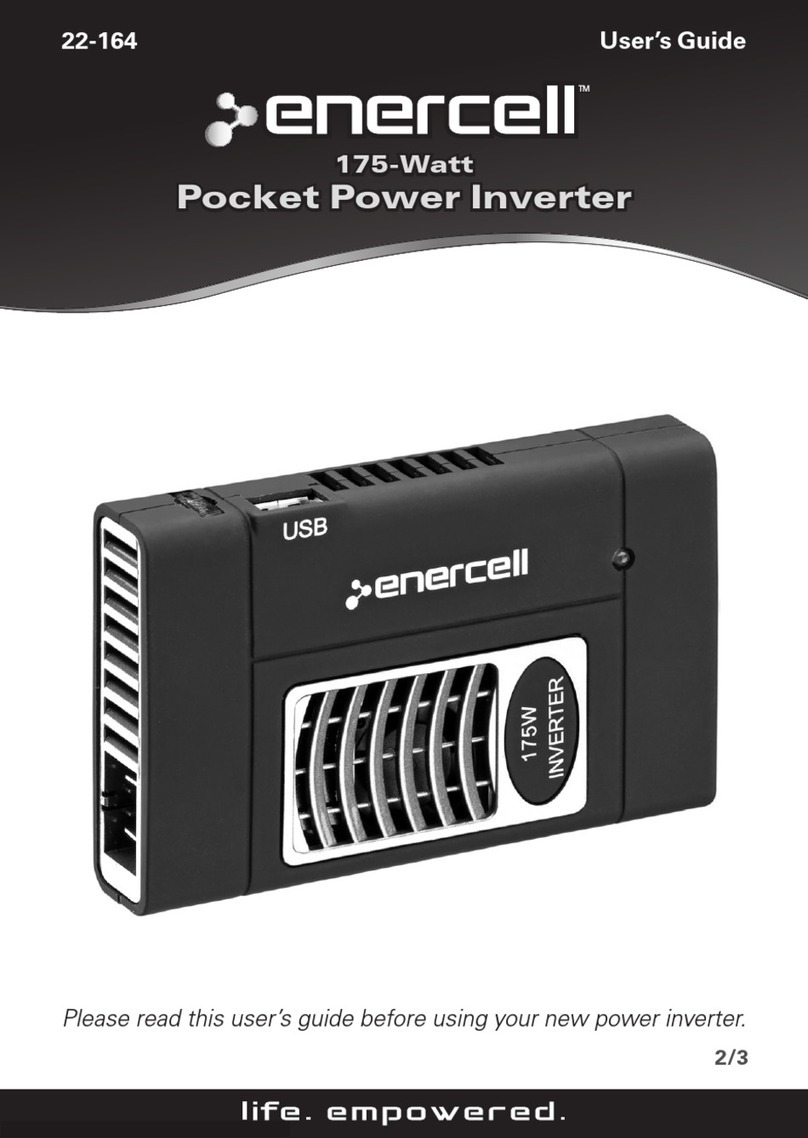
Enercell
Enercell 175-Watt Pocket Power Inverter user guide
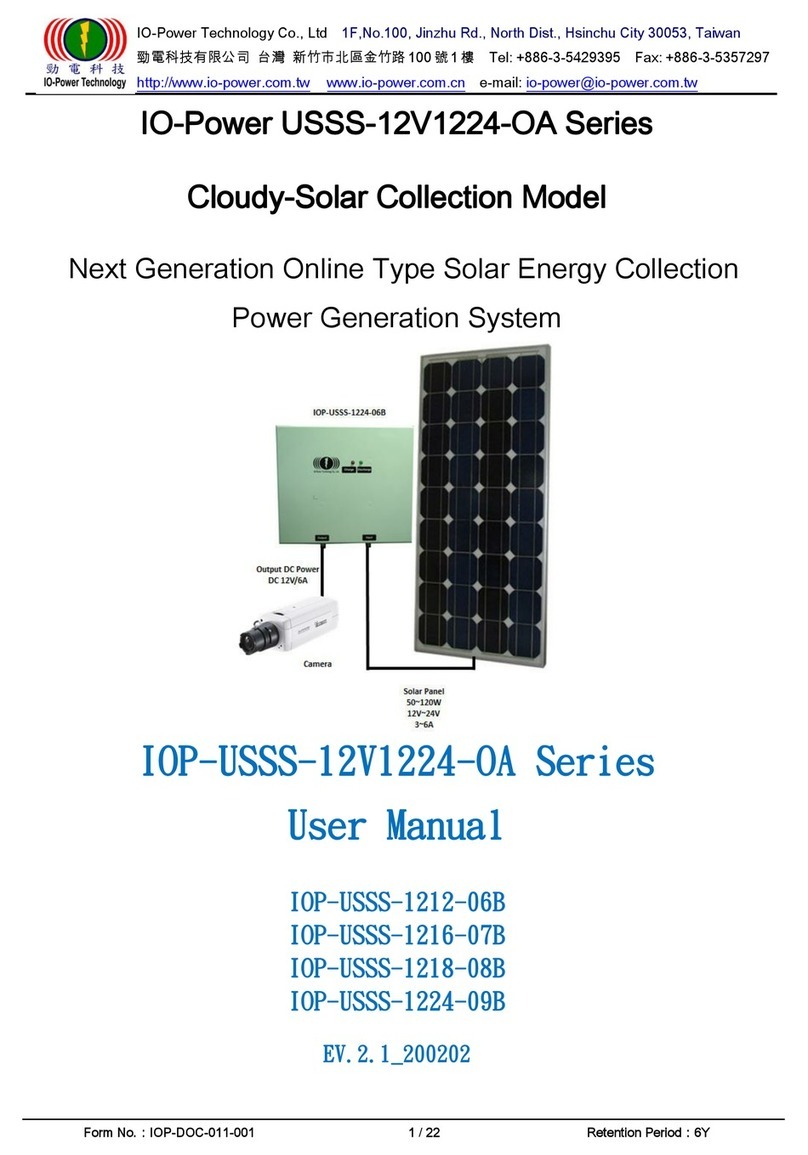
IO-Power Technology
IO-Power Technology Cloudy-Solar Collection IOP-USSS-12V1224-OA... user manual
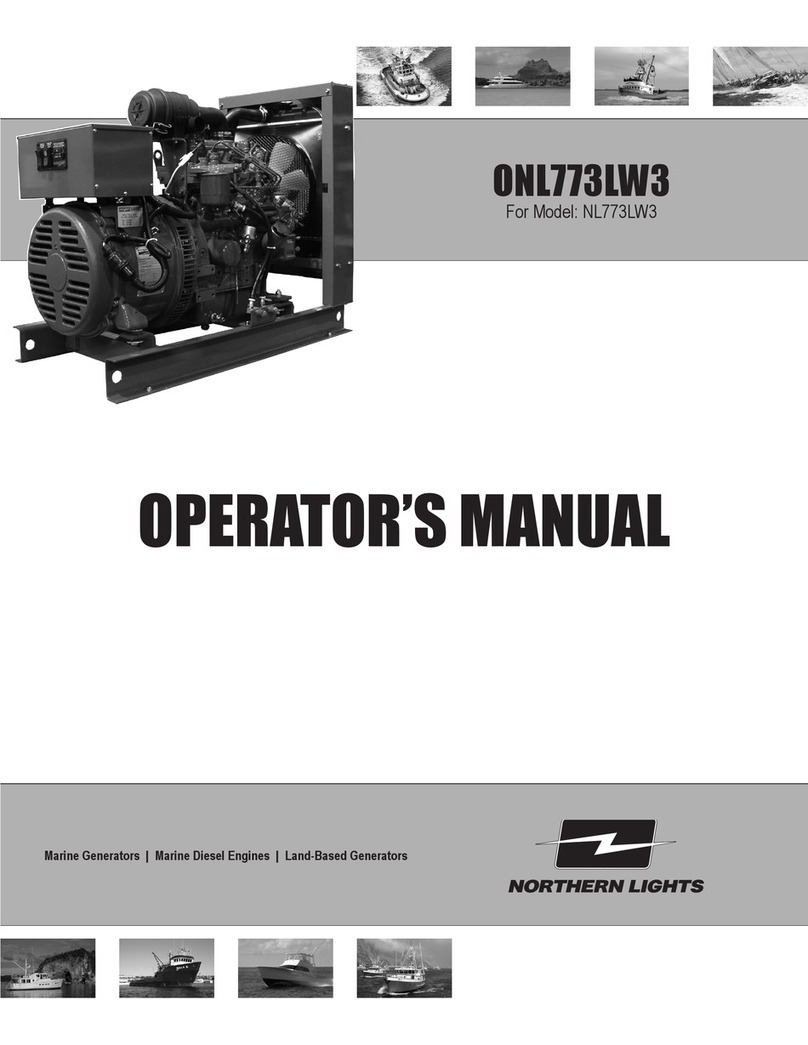
Northern Lights
Northern Lights NL773LW3 Operator's manual
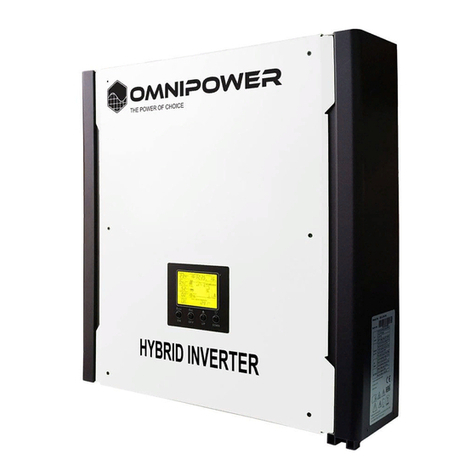
OmniPower
OmniPower OHY1P4803 user manual

Victron energy
Victron energy Phoenix Inverter Smart 12/1600 manual
